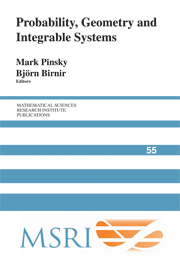Book contents
- Frontmatter
- Contents
- Preface
- Henry McKean: A tribute by the editors
- Bitangential direct and inverse problems for systems of differential equations
- Turbulence of a unidirectional flow
- Riemann–Hilbert problem in the inverse scattering for the Camassa–Holm equation on the line
- The Riccati map in random Schrödinger and random matrix theory
- SLE6and CLE6 from critical percolation
- Global optimization, the Gaussian ensemble, and universal ensemble equivalence
- Stochastic evolution of inviscid Burgers fluid
- A quick derivation of the loop equations for random matrices
- Singular solutions for geodesic flows of Vlasov moments
- Reality problems in the soliton theory
- Random walks and orthogonal polynomials: some challenges
- Integration of pair flows of the Camassa–Holm hierarchy
- Landen Survey
- Lines on abelian varieties
- Integrable models of waves in shallow water
- Nonintersecting Brownian motions, integrable systems and orthogonal polynomials
- Homogenization of random Hamilton–Jacobi–Bellman Equations
Random walks and orthogonal polynomials: some challenges
Published online by Cambridge University Press: 27 June 2025
- Frontmatter
- Contents
- Preface
- Henry McKean: A tribute by the editors
- Bitangential direct and inverse problems for systems of differential equations
- Turbulence of a unidirectional flow
- Riemann–Hilbert problem in the inverse scattering for the Camassa–Holm equation on the line
- The Riccati map in random Schrödinger and random matrix theory
- SLE6and CLE6 from critical percolation
- Global optimization, the Gaussian ensemble, and universal ensemble equivalence
- Stochastic evolution of inviscid Burgers fluid
- A quick derivation of the loop equations for random matrices
- Singular solutions for geodesic flows of Vlasov moments
- Reality problems in the soliton theory
- Random walks and orthogonal polynomials: some challenges
- Integration of pair flows of the Camassa–Holm hierarchy
- Landen Survey
- Lines on abelian varieties
- Integrable models of waves in shallow water
- Nonintersecting Brownian motions, integrable systems and orthogonal polynomials
- Homogenization of random Hamilton–Jacobi–Bellman Equations
Summary
The study of several naturally arising “nearest neighbour” random walks benefits from the study of the associated orthogonal polynomials and their orthogonality measure. I consider extensions of this approach to a larger class of random walks. This raises a number of open problems.
1. Introduction
Consider a birth and death process, i.e., a discrete time Markov chain on the nonnegative integers, with a one step transition probability matrix ℙ. There is then a time-honored way of writing down the n-step transition probability matrix ℙn in terms of the orthogonal polynomials associated to ℙ and the spectral measure. This goes back to Karlin and McGregor [1957] and, as they observe, it is nothing but an application of the spectral theorem. One can find some precursors of these powerful ideas, see for instance [Harris 1952; Ledermann and Reuter 1954]. Inasmuch as this is such a deep and general result, it holds in many setups, such as a nearest neighbours random walk on the Nth-roots of unity. In general this representation of ℙn allows one to relate properties of the Markov chain, such as recurrence or other limiting behaviour, to properties of the orthogonality measure.
In the few cases when one can get one's hands on the orthogonality measure and the polynomials themselves this gives fairly explicit answers to various questions.
The two main drawbacks to the applicability of this representation (to be recalled below) are:
a) typically one cannot get either the polynomials or the measure explicitly.
b) the method is restricted to “nearest neighbour” transition probability chains that give rise to tridiagonal matrices and thus to orthogonal polynomials.
Information
- Type
- Chapter
- Information
- Probability, Geometry and Integrable Systems , pp. 241 - 260Publisher: Cambridge University PressPrint publication year: 2008
